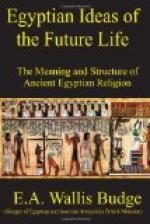NU was the “father of the gods,”
and progenitor of the “great company
of the gods”; he was the primeval
watery mass out of which all things
came.
PTAH was one of the most active of the three great gods who carried out the commands of Thoth, who gave expression in words to the will of the primeval, creative Power; he was self-created, and was a form of the Sun-god R[=a] as the “Opener” of the day. From certain allusions in the Book of the Dead he is known to have “opened the mouth” [Footnote: “May the god Ptah open my mouth”; “may the god Shu open my mouth with his implement of iron wherewith he opened the mouth of the gods” (Chap. XXIII.)] of the gods, and it is in this capacity that he became a god of the cycle of Osiris. His feminine counterpart was the goddess SEKHET, and the third member of the triad of which he was the chief was NEFER-TEMU.
PTAH-SEKER is the dual god formed by fusing
Seker, the Egyptian name
of the incarnation of the Apis Bull of
Memphis, with Ptah.
PTAH-SEKER-AUSAR was a triune god who,
in brief, symbolized life,
death, and the resurrection.
KHNEMU was one of the old cosmic gods who assisted Ptah in carrying out the commands of Thoth, who gave expression in words to the will of the primeval, creative Power, he is described as “the maker of things which are, the creator of things which shall be, the source of created things, the father of fathers, and the mother of mothers.” It was he who, according to one legend, fashioned man upon a potter’s wheel.
KHEPERA was an old primeval god, and the type of matter which contains within itself the germ of life which is about to spring into a new existence; thus he represented the dead body from which the spiritual body was about to rise. He is depicted in the form of a man having a beetle for a head, and this insect became his emblem because it was supposed to be self-begotten and self-produced. To the present day certain of the inhabitants of the Sudan, pound the dried scarabaeus or beetle and drink it in water, believing that it will insure them a numerous progeny. The name “Khepera” means “he who rolls,” and when the insect’s habit of rolling along its ball filled with eggs is taken into consideration, the appropriateness of the name is apparent. As the ball of eggs rolls along the germs mature and burst into life; and as the sun rolls across the sky emitting light and heat and with them life, so earthly things are produced and have their being by virtue thereof.
R[=A] was probably the oldest of the gods worshipped in Egypt, and his name belongs to such a remote period that its meaning is unknown. He was in all periods the visible emblem of God, and was the god of this earth to whom offerings and sacrifices were made daily; time began when R[=a] appeared above the horizon at creation in the form of the Sun, and the life of a man was compared to




